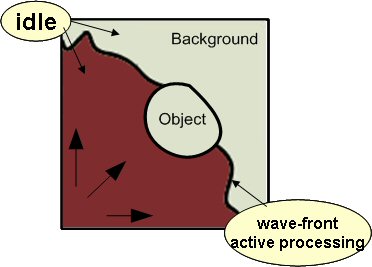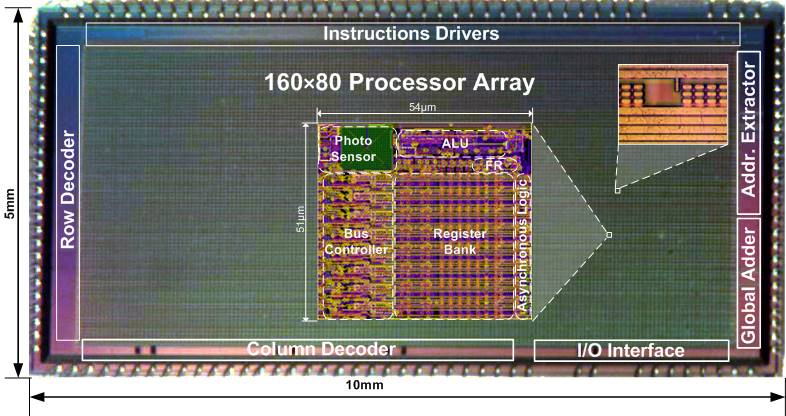ASPA - Asynchronous/Synchronous Cellular Processor
Array
 This project investigates design of vision
chips and fine-grain processor arrays based on novel control schemes,
where individual processors are triggered as data is available at their
neighbours, optimising speed and power consumption of the devices. The
aim is to provide image processing engines suitable for both low-level,
pixel-based operations (filtering, feature detection etc.) as well as
more global, object-based algorithms, such as object reconstruction,
skeletonisation, watarshed transform, distance transform etc. The ASPA
chip contains a SIMD processor array, operating in mixed
bit-serial/bit-parallel mode, as well as a wave-propagating
network.
This project investigates design of vision
chips and fine-grain processor arrays based on novel control schemes,
where individual processors are triggered as data is available at their
neighbours, optimising speed and power consumption of the devices. The
aim is to provide image processing engines suitable for both low-level,
pixel-based operations (filtering, feature detection etc.) as well as
more global, object-based algorithms, such as object reconstruction,
skeletonisation, watarshed transform, distance transform etc. The ASPA
chip contains a SIMD processor array, operating in mixed
bit-serial/bit-parallel mode, as well as a wave-propagating
network.
Wave
Propagation Computing
In a wave-propagating array, individual processors are
activated by data-flow, as neighbours complete their computations. This results in high efficiency
as compared with SIMD processor array for
algorithms such as trigger-waves,
distance transforms, skeletons, etc.
Integrate
Circuit Prototypes
 The first
proof-of-concept ASPA
chip has been fabricated in 0.35um CMOS technology. The
performance of a single PE is 10 MOPS (gray-scale additions) 83 MOPS
(binary operations) and 2.9 GOPS (binary propagations, as compared with
SIMD array). The chip efficiently executes wave-propagation based
algorithms - in addition to functioning as a general purpose fine-grain
processor array, suitable for real-time image processing and other
array based computations. It also integrates image sensors in a
pixel-per-processor architecture.
The first
proof-of-concept ASPA
chip has been fabricated in 0.35um CMOS technology. The
performance of a single PE is 10 MOPS (gray-scale additions) 83 MOPS
(binary operations) and 2.9 GOPS (binary propagations, as compared with
SIMD array). The chip efficiently executes wave-propagation based
algorithms - in addition to functioning as a general purpose fine-grain
processor array, suitable for real-time image processing and other
array based computations. It also integrates image sensors in a
pixel-per-processor architecture.
The
second generation ASPA-2 chip
has been
designed
in a 180nm CMOS technology. It contains 80x80 processor array, with
synchronous SIMD and asynchronous wave-propagating mode. Peripherial
circuits perform coordinate address extraction for efficient object
localisation and tracking
The
latest chip in this family,
ASPA-3, has a 160x80 processor array.
The
chip is fabricated in a 180nm CMOS technology. It is a vision chip,
including a pixel-parallel SIMD cellular processor array operating in a
synchronous mode, as well as asynchronous propagation circuits.
Future
Work
We
are continuing our work on pixel-parallel cellular processor array in
the recently-funded EPSRC project on
"Fine-Grain Processor Arrays in 3D Silicon Technologies (FINE3D)"
Publications:
A.Lopich and P.Dudek, "A SIMD Cellular Processor Array Vision Chip With Asynchronous Processing Capabilities", IEEE Transactions on Circuits and Systems - I, vol 58, issue 10, pp. 2420-2431, October 2011
A.Lopich and P.Dudek, "Asynchronous Cellular Logic Network as a Co-Processor for a General-Purpose Massively Parallel Array",International Journal of Circuit Theory and Applications, Volume 39, Issue 9, pages 963–972, September 2011
A.Lopich and
P.Dudek, Hardware
Implementation of Skeletonization Algorithm for Parallel Asynchronous
Image Processing, Journal of Signal
Processing Systems, Springer, Volume 56, Number 1,
pp. 91-103, July 2009
A.Lopich
and P.Dudek, "ASPA:
Focal Plane Digital Processor Array with Asynchronous Processing
Capabilities", IEEE International Symposium on Circuits and
Systems, ISCAS 2008, pp 1592-1596, May 2008
A.Lopich and P.Dudek, "Implementation
of an Asynchronous Cellular Logic Network as a Co-Processor for a
General-Purpose Massively Parallel Array", European
Conference on Circuit Theory and Design, ECCTD 2007, pp.84-87, Seville,
Spain, August 2007
A.Lopich
and P.Dudek, “Global
operations on SIMD cellular processor arrays: towards functional
asynchronism”, International Workshop on Computer
Architectures for Machine Perception and Sensing, CAMPS 2006, pp.18-23,
September 2006
P.Dudek,
"An
Asynchronous Cellular Logic Network for Trigger-Wave Image Processing
on Fine-Grain Massively Parallel Arrays", IEEE
Transactions on Circuits and Systems - II, vol. 53, no.5, pp.
354-358, May 2006
Dr Piotr Dudek, School of
Electrical and Electronic Engineering, The University of Manchester, PO
Box 88, Manchester M60 1QD, UK, Email: p.dudek@manchester.ac.uk
 This project investigates design of vision
chips and fine-grain processor arrays based on novel control schemes,
where individual processors are triggered as data is available at their
neighbours, optimising speed and power consumption of the devices. The
aim is to provide image processing engines suitable for both low-level,
pixel-based operations (filtering, feature detection etc.) as well as
more global, object-based algorithms, such as object reconstruction,
skeletonisation, watarshed transform, distance transform etc. The ASPA
chip contains a SIMD processor array, operating in mixed
bit-serial/bit-parallel mode, as well as a wave-propagating
network.
This project investigates design of vision
chips and fine-grain processor arrays based on novel control schemes,
where individual processors are triggered as data is available at their
neighbours, optimising speed and power consumption of the devices. The
aim is to provide image processing engines suitable for both low-level,
pixel-based operations (filtering, feature detection etc.) as well as
more global, object-based algorithms, such as object reconstruction,
skeletonisation, watarshed transform, distance transform etc. The ASPA
chip contains a SIMD processor array, operating in mixed
bit-serial/bit-parallel mode, as well as a wave-propagating
network.  The first
proof-of-concept
The first
proof-of-concept